This is the first of two pages containing information about the 2017 Transcontinental Race No5. See the Overview page for a general introduction to the Transcontinental Race (TCR). See also the official TCR page.
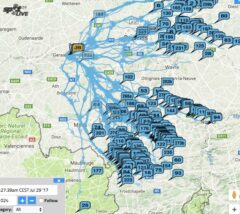
The information is presented across two pages:
- Tragedies & Race Organization
- Route Summary
- Results Highlights
- Media Coverage (on the next page)
- Full Results & Ride Reports (on the next page)
- Registration Process (on the next page)
Tragedies & Race Organization
Mike Hall, the race’s director and founder in 2013, sadly died in a collision with a car in late March 2017 while taking part in the inaugural 2017 Indian Pacific Wheel Race. Planning for the 2017 edition of the TCR was postponed while everyone mourned the immense loss and there were fears that the race would not happen.
Fortunately, a team of volunteers were able to put things in place to enable the 2017 edition of the race to go ahead. Read this article on Apidura’s blog to know more about this process and the team. Many memorial rides were organized all over the world shortly after Mike’s death, but there cannot be any bigger memorial ride than the race that he founded, so many of the participants were riding with him in their thoughts. Some videos that Mike recorded during the previous 6 months about the rules and spirit of the race were shown during the rider briefing before the start.
Rider safety had been a major focus of this edition of the race after Mike Hall’s death and also that of Eric Fishbein in the Trans Am Bike Race less than two months before the start. Tragically, Dutch rider Frank Simons was hit by a car in southern Belgium and died during the first night of the race. You can read about Frank’s life and passions in this post on the TCR blog. The incident happened at around 3am, five hours into the race, during which Frank had ridden about 90 km. The driver fled the scene, but the next day turned themselves in at a police station and an investigation is ongoing.
Everyone’s thoughts turned to Frank’s family and friends and the safety of the rest of the riders. Frank was an experienced audax rider / randonneur and his family told the race organizers that Frank would have wanted the race to continue, so the organizers decided not to cancel the race and leave the decision of whether to contiunue up to each rider to make individually and they ensured that everyone was aware of the situation when they passed through the first checkpoint.
Most people chose to continue the race, but some decided that the risks were too great or they no longer had the motivation to continue. One of the race leaders at the time, Björn Lenhard, summarized one point of view quite clearly that if he were to stop racing now then he may as well stop cycling completely because these instances can happen at any time, when cycling to work, riding for fun near home, or anywhere (see this video). Other riders decided that the perceived risks were too high either for them or for their family to tolerate and so either scratched from the race or chose to continue but at a more leisurely pace without trying to race. To read about the tragedy from the perspective of the race coordinator, Juliana Buhring, see this article at CyclingTips.
Route Summary
The checkpoints for TCR No5 were announced in early Novemeber 2016 at an event in Milan, Italy with the event’s title sponsors PEdALED; see this video of the event. The map below shows the simplified route. As in the previous two years, the race started in Geraardsbergen, Belgium with an ascent of the cobbled climb, the Muur van Geraardsbergen, but that was the only location used in 2017 that had been used previously. The start time was 10pm, on 28th July, 2017.
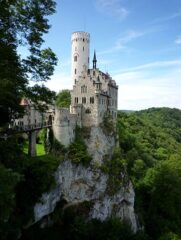
To view all of the rider tracks at once, go to Trackleaders and click on the ‘T’ button above the map or click on an individual rider’s name to see just one track. To be amused by the little dots moving across the map, click on the Play button in the replay box in the bottom-left of the map – a replay speed of x2048 works well.
Germany hosted a checkpoint for the first time in the race’s history, with the location of checkpoint 1 (CP1, sponsored by Lezyne) being the Schloss Lichtenstein castle in the Swabian Jura, with riders choosing radically different routes to get between the start and CP1. The most direct route went through the Ardennes hills in Belgium, the valleys of Luxembourg, and the Black Forest in Germany. The flattest, but much longer option went much further north, near Brussels and then onto the Rhine river valley in Germany. The option with an intermediate amount of distance and climbing was to head more south and go across north-eastern France.

The Alps had to be crossed to reach CP2 at Monte Grappa in Italy (CP2 was sponsored by PEdALED). Riders used five different passes to cross the spine of the Alps, the most popular being the relatively easier but busier Brenner or Reschen passes between Austria and Italy. It was therefore possible to cross the Alps without going above 2000 meters elevation for the first time in the race’s history. Some people took a slightly more direct route that climbed much higher over the Timmelsjoch Pass. A few people chose to go through Switzerland and over the Fluela or Albula Pass.
Monte Grappa was a major battlefield in both World Wars I and II. The hardest version of the climb was used as the obligatory parcours for CP2, starting near Bassano del Grappa and rising 1550 meters in under 20km, with most of the climb at a gradient of between 8 and 11%.
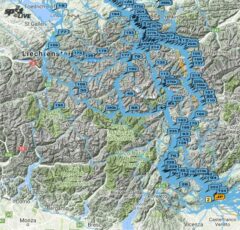
The temperatures in northern Europe had been mild with a few rain storms. Once the riders crossed the Alps, they ran into a heatwave that the media named “Lucifer” that affected all of southern and eastern Europe for the remainder of the race. The air temperature was regularly above 40°C (104°F), and the temperature on the road with the direct sun and the heat radiating off of the tarmac would have been much higher. This caused many people problems that forced them to scratch from the race. Lucifer received a lot of media attention, including this article in The Guardian newspaper and some of the temperatures are listed in this post in the TCR Facebook group.
CP3 (sponsored by Kinesis UK) was in the High Tatra mountains in northern Slovakia, the race’s first visit to anywhere in that region. The main route options were through Austria, passing near Klagenfurt and onto Bratislava or staying further south and going across Slovenia then Hungary. As people left the more familiar countries of western Europe and the heat started to make riding increasingly difficult, a higher proportion of people scratched between these two checkpoints than between any others during previous TCRs. The CP3 parcours was a 7 km long climb with an average 10% gradient, with some sections unpaved, ending at a hotel and mountain lake in the Tatra National Park.
Most riders reported it to be difficult to find an optimal route across eastern Europe due to the unpredictability of which roads they were allowed to cycle on, how busy other roads were, whether they were wide enough for the volume of traffic, and whether alternative side roads were paved, gravel, or sometimes just sand. Such problems had been encountered by participants in prior editions of the race, which had spent a lot of time in the countries that were formerly part of Yugoslavia plus Albania, but Hungary and Romania were reported to be far worse in this regard.
It had been announced before the race started that several roads that cyclists can legally use would not be allowed during the race due to safety concerns (see this map). During the race, the organizers took the unprecedented decision to ban the use of a road while the race was taking place (see this announcement). The first and second place riders both used a section of the E81 in Romania but found it to be one of the worst roads they had experienced anywhere in terms of safety and so informed the organizers, who then attempted to warn all other riders as they passed through CP3 that this road was now banned and the first two riders accepted a time penalty so that they didn’t gain any advantage.
The most popular route to CP4, which was the Transfagarasan Pass in the mythical region of Transylvania (CP4 was sponsored by Apidura), Romania, passed near to the large city of Cluj, but a wide variety of alternative routes were used, including one rider who crossed the corner of Ukraine. The presence of brown bears in the Carpathian Mountains had worried some participants before the start of the race, and a few riders actually saw bears by the roadside near CP4. The climb itself is not steep, but rises to over 2000 metres elevation and passes through a remote area containing very few services for an extended distance. The mandatory parcours was the longest ever used by the TCR at almost 90 km.
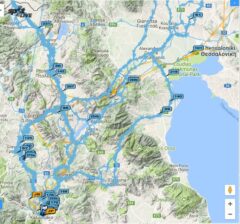
Despite being Europe’s second longest river, the Danube (Donau in German) had never featured strongly in previous editions of the TCR (the Volga in Russia is Europe’s longest river). In TCR No1, some riders crossed the Danube not far from it’s source in the Black Forest and in TCR No3, one of the checkpoints was in Vukovar, Croatia, which is on the river. In this year’s edition of the race all riders had to cross the Danube three times: once shortly after CP1 in Germany, a second time to enter Slovakia on the way to CP3, and then again between CP4 and the finish. Options of where to cross the mighty river the final time were quite limited, and this choice basically determined whether people headed south towards Sofia in Bulgaria or west towards Serbia. Some people crossed the river on a ferry rather than using a bridge.
Due to the most direct border crossing between Bulgaria and the finish in northern Greece being a motorway that cyclists are not allowed on, almost everyone chose to enter Greece via Macedonia, with many people using the border near Lake Dojran, but most going via Bitola. The most direct way towards Bitola went over the mountains on the R1312 road, which although it is marked as a major road on most maps, the upper part is unpaved for a long section and is in very bad condition; many people who chose this supposed shortcut reported walking for a significant distance, getting punctures or sustaining other damage to their bike and shoes, and often losing significant time.
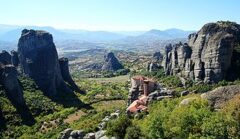
The finish was in Kalabaka, Greece, near the Meteora monasteries, with the final parcours passing the monasteries that stand on pinnacles of rock above the town. Riders approached the parcours from either the north or east, with some of the easterly riders avoiding the hills as much as posible by riding along the Aegean Sea for a short distance. Although there was a paved road that climbed up to the top of the downhill parcours, a few people found a gravel road along the ridge of hills to the east that allowed them to sneak onto the parcours (or, at least, they would have been sneaky if their satellite trackers hadn’t been showing the whole world what they were doing).
Whereas the first four editions of the race finished in Turkey, this edition finished in Greece. Many people assumed that this was due to political unrest in Turkey, but Mike Hall said that he just wanted to keep things fresh and interesting – both the UK and Belgium have hosted the start and many different countries have hosted checkpoints, so why should the finish not also vary?
The distance ridden by most finishers was about 3900-4200 km. This is slightly longer than in 2016, but with less climbing, and slightly less distance than the 2015 edition. Most riders reported that the heat and road conditions were the biggest obstacles to overcome.
The day after the finish party, a group ride around Kalabaka was organized in memory of Frank Simons. One of Frank’s sons, Job, came from the Netherlands to attend the ride and some photos of the ride are in this Facebook post.
Results Highlights
James Hayden (UK) was most people’s pre-race favorite due to riding near the front of the race in 2015 and 2016, but encountering problems each time that denied him a podium position. Björn Lenhard (Germany) was the most likely contender, having been in second place at CP2 in 2016 before experiencing problems himself. See this blog post for a pre-race analysis.
At CP1, it was Geoffroy Dussault (Canada) who was leading. Geoffroy finished 7th in 2016, and obviously wanted to improve on that this time. He was followed by Jonas Goy (Switzerland), who had been in the top 5 at CP4 in 2015 before scratching, and then came Björn then James.
By CP2, Björn had moved up to first place, with Jonas again in second (despite stopping for more than 12 hours at CP1 to decide what to do after hearing about the death of Frank Simons); Geoffroy was now in 3rd and James still in 4th.
Björn was still leading at CP3, but by then James was close behind him and Jonas wasn’t far behind. James passed Björn shortly after CP3, but the two stayed close and were both on the parcours of CP4 at the same time.
James Hayden started to pull away after CP4, eventually winning in just under 9 days, about 14 hours ahead of Björn Lenhard (see this comment in the TCR Facebook group highlighting where the differences were). Jonas Goy held onto his third place from CP3 to the finish.
After Geoffroy Dussault was 1st at CP1, he fell back a bit in the middle of the race but finished strongly to take fourth place. Matthew Falconer also finished strongly at the end and profited from two of the people who finished before him receiving penalties and so he was awarded fifth place. Rory McCarron (UK) was sixth and the highest-ranked rookie.
This edition of the race was therefore the closest-fought of the five editions so far, with three different leaders at different checkpoints, the final lead change being the furthest into the race and the winning margin being the smallest. The first four finishers were separated by just over 24 hours, which is often the difference between first and second places. One of the reasons for this is that in most previous editions, several people who spent some time in the top 5 positions have had major problems and scratched from the race. This time, the people at the very front generally avoided serious problems and finished the race. In fact, any person who passed any checkpoint in the top 5 positions eventually finished the race.
More women started the race than ever before – 28 of the 282 starters, so it was also a new record in terms of the percentage of the starters. Only 34 women had started in TOTAL across the previous four editions.
One of the rookies, Melissa Pritchard (USA), lead all women at every checkpoint and the finish and was 30th overall in just over 13 days. Karen Tostee (UK) had been quite close behind Melissa until she got sick in the last couple of days, and Ingeborg Dybdal Oie (Norway) narrowly beat her to finish as the second woman with Karen third. Last year’s fastest woman, Emily Chappell (UK), scratched after CP2.
The first pair to finish was Ian Tosh (UK) and Neil Lauder (UK), who finished in just under 14 days, but they took several banned roads so their penalties pushed them down to 4th place in the final classification. The winners of the pairs category were therefore Anders Syvertsen (NOR) and Eivind Tandrevold (NOR). For the first time, an all-female pair finished the race, Angela Walker (UK) and Julie Bullen (UK) in just under 20 days; the only other all-female pair to start the race had been in 2015, but only one of that pair finished.
In the end, 146 people finished and 136 people scratched. The finishing rate of 52% is practically the same as the previous lowest value, which was in TCR No3, 2015. Detailed analysis of all the results, summaries of indivual’s performances and links to ride reports and social media are all given in the tables at the bottom of the next page.
Last significant page update: December, 2017
This page is in the The Transcontinental Race section. The next page in this section is:
